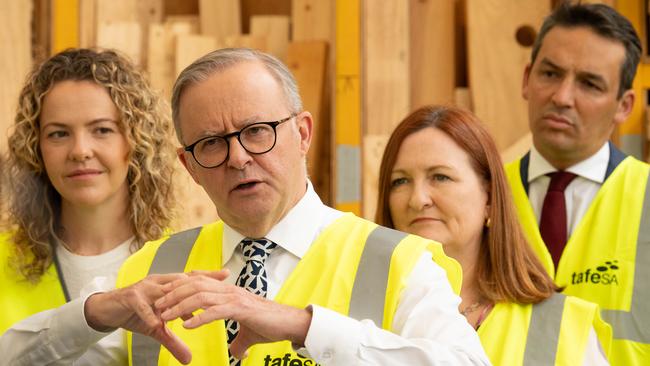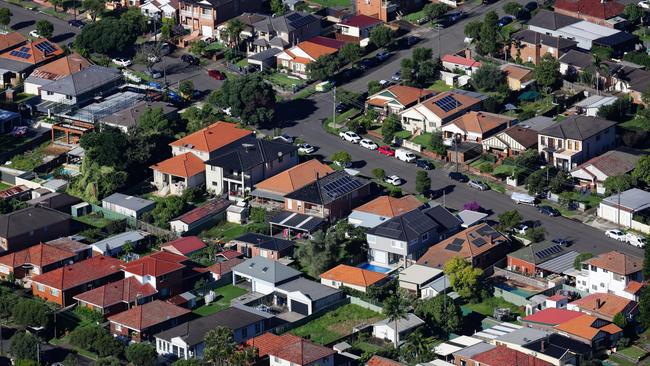Anthony Albanese’s homes target falling short as new apartments dry up
Slow growth in new apartments and Sydney’s weak home building market have fuelled warnings that Labor’s 1.2 million new homes by mid-2029 target will fall short by about 20 per cent.

Slow growth in new apartment builds and a sharp slowdown in detached housing construction in Sydney have Anthony Albanese on course to fall about 20 per cent short of Labor’s target to build 1.2 million new homes by mid-2029.
New forecasts obtained by The Australian reveal a “grim downward revision” for multi-unit starts, which means hot demand for housing, fuelled by elevated migration and a strong labour market, cannot be met.
On current trajectories, the Housing Industry Association is forecasting 983,500 home builds will commence over five years to mid-2029, which is 216,500 short of the Prime Minister’s 1.2 million new homes target.
The HIA, which will release its National Outlook forecasts and election platform in the NSW South Coast Labor-held seat of Gilmore on Friday, warned that “despite growing demand for apartments, the reality is that multi-unit starts are languishing at their lowest levels in over a decade – and they’re unlikely to increase tangibly for at least another year”.
Gilmore MP Fiona Phillips, who holds the marginal seat by 0.2 per cent, will attend the HIA event at a Nowra building site alongside Liberal Party candidate and former NSW minister Andrew Constance.
With Mr Albanese and Peter Dutton finalising election announcements underpinning competing plans to fix the housing crisis, HIA chief economist Tim Reardon said “we continue to anticipate that the volume of new home commencements will fall around 20 per cent short of the government’s goal of 1.2 million”.
“Despite initiatives aimed at encouraging home building, the collective impact of higher taxes on new homes has offset any gains,” Mr Reardon told The Australian.
Mr Albanese on Thursday launched a defence of why Labor’s $10bn Housing Australia Future Fund, which promised to build 30,000 new homes over five years, has not delivered a single home. The Labor leader blamed the Coalition and Greens for stalling the HAFF in the Senate.
“If you make a decision to build a house today, I assure you that you won’t purchase the land, get the planning approvals, do all that and have the house built and move in in six months. That would be remarkable. We were elected in 2022, less than three years ago. The legislation was delayed by a year,” Mr Albanese said.
The HIA National Outlook, which includes updated building forecasts, said “the most significant policy-induced roadblock remains the multi-unit sector … government-imposed taxes and charges have stifled apartment construction, even as migration levels remain at record highs”.
“During the last apartment boom, Australia was commencing over 25,000 units per quarter for five years. In contrast, the current figure sits at around 15,000 per quarter. At a minimum, unit construction needs to double from current levels to meet the Australian government’s goal of delivering 1.2 million homes over five years.
“But this goal cannot be achieved, even with lower interest rates, while state governments continue to increase taxes on homes, notably NSW, Victoria and Queensland.”
Another pressure point for Australia’s housing market is new detached homes in Sydney, which remain low compared with other capital cities. The number of detached house approvals across Sydney in 2024 was 12,490, behind Melbourne (24,599), Perth (15,007) and Brisbane (13,462).

Mr Reardon said “home building in Sydney has stalled, with both detached and units at decade lows and, unlike anywhere else in the country, they remain stalled”.
The HIA chief economist, who expects another two interest rate cuts this year, said Sydney families were opting for home renovations and extending their properties.
“The Sydney market hasn’t picked up and that’s because the average cost of a new house-and-land package in western Sydney is about $1.5m. In Melbourne it’s $950,000, in Brisbane it’s $900,000, Perth it’s about $700,000. The typical Australian household can borrow $850,000-$900,000 depending on which state they’re in.
“NSW is fine. Building outside of the Sydney basin is responding to growing demand and low unemployment, with a growth in starts.”
HIA managing director Jocelyn Martin said the current policy and economic environment was “putting a handbrake on our industry, resulting in only 170,000 new homes being delivered” instead of the 240,000 new dwellings required per year to meet demand.
The HIA election platform focuses on reducing upfront and hidden taxes on housing, unlocking more land supply through planning reforms, cutting more red tape, overhauling financial settings to make home ownership achievable for more Australians, and addressing chronic skills shortages.




To join the conversation, please log in. Don't have an account? Register
Join the conversation, you are commenting as Logout